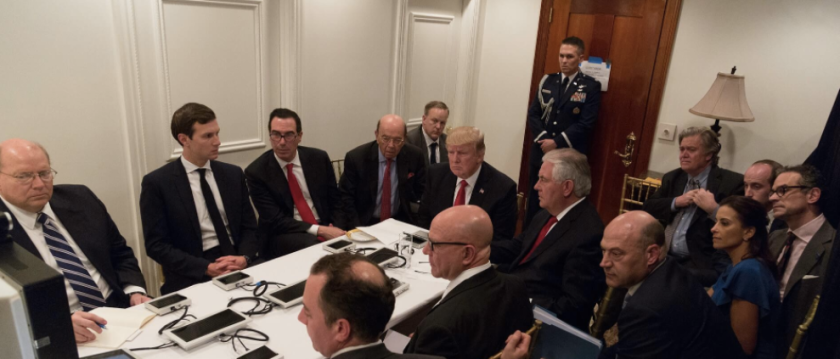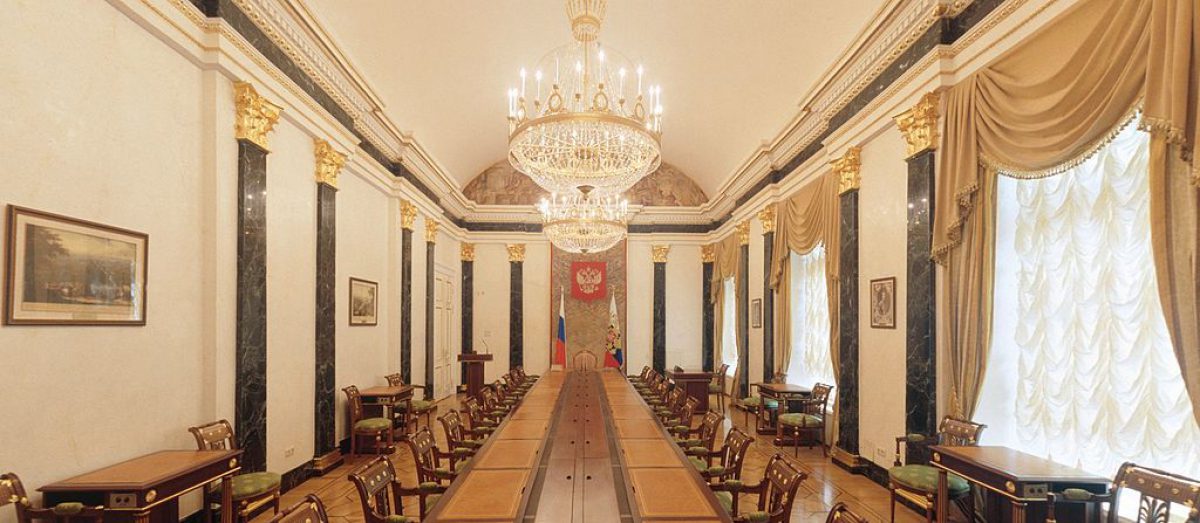
One of the most popular narratives currently surrounding the Trump presidency is that it is an administration beset by internal power struggles. Virtually since the very day Trump was sworn into office, rumors have swirled of bitter conflict, especially between the president’s son-in-law, Jared Kushner, and the reputed ‘grey eminence’ of Steve Bannon. Yet while this particular narrative has gained a great deal of traction in the American press, in Russia the purportedly fractious nature of Trump’s inner circle is understood quite differently.
Last week, the Valdai International Discussion Club – a Kremlin-organized policy forum – published an article touching on this very subject. Authored by Valdai Club program Director Oleg Nikoaleivch Barabanov, the article in question opens with a brief analysis of efforts by the US Republican Party to ‘normalize’, or rein in Trump. Displaying a keen understanding of the idiosyncratic political calculus guiding the GOP in the aforementioned endeavor, Barabanov writes:
“The urgency of this effort is rather obvious. Trump’s refusal to fall in line with the expectations of the majority of the US political and media establishment is steadily increasing. The scenario of Trump’s impeachment and removal from power is being discussed more openly. But it is also obvious that this is not only about Trump’s personal fate. The image of the Republican Party as a whole will be seriously damaged by Trump’s impeachment and by the continuation of his confrontational style of politics. This situation presents a real danger to the Republican Party ahead of next year’s midterm elections. Thus, in the opinion of influential Republican politicians and experts, it would be much better to avoid further exacerbations.”
That Trump has yet to acquiesce fully to the Republican Party goes without saying. Barabanov rightly points out that many within the GOP have adopted a “wait-and-see” attitude to President Trump, with the result being that few if any Republicans have volunteered to serve in the current White House. Per Barabanov, this has resulted in a “professional vacuum” around President Trump. Yet he also contends that this vacuum has already begun to be filled – not by politicians, but by high-ranking military officers such as Secretary of Defense James Mattis and National Security Advisor Herbert McMaster.
Whereas some in the United States regard Mattis and McMaster as an “effective stabilizing force” capable of moderating Trump’s maverick foreign policy, Barabanov reasons that amidst the prevailing political confusion, “there now exists a rare window of opportunity for this same personnel to take decisive action.” In this sense, Barabanov maintains that the leadership of the US military has emerged as a distinct faction within Trump’s “inner circle.”
This notion may strike American audiences as rather odd, given that the military is generally regarded as being an apolitical institution. However, as with any government institution, the US military also has its interests of own – the most important being, according to no less an authority than the Department of Defense itself, to “provide the military forces needed to deter war and to protect the security of [the United States].”
Yet Barabanov warns that the US military’s disproportionate influence within the Trump White House betokens a broader “militarization” of US foreign policy, wherein all diplomacy – including with putative US rivals Russia and China – may be conducted from a position of force. Alluding to the positive reaction to the April 6 airstrike on Syria’s Shayrat airfield as proof, Barabanov maintains that this strategy has gained popular legitimacy, and as such predicts that Trump will continue to carry out “conspicuous demonstrations of force” in order to demonstrate his resolve to Moscow and Beijing.
Barabanov notes that the growing influence of the US military within the White House ironically threatens to undermine the very diplomatic channels through which Moscow and Washington have averted an armed confrontation in the past. Building on this point, he references rumors that Trump intends to slash the State Department’s budget by as much as a third and to pass the savings along to the Pentagon. From the Russian position, this would create an unstable and highly dangerous dynamic wherein the avenues for potential conflict vastly outnumber those for mediation and conflict resolution.
For Barabanov, this looming dynamic threatens nothing less than the disinterment of the Cold War’s worst, most unspeakable specter – namely, the scenario of nuclear war. Citing recent tensions on the Korean peninsula as an example, Barabanov suggests that the US military may be encouraging Trump to provoke the North Korean leadership into making good on its long-standing threat to turn Seoul into a “sea of flames” with a tactical nuclear strike. In doing so, he contends, the taboo on using nuclear weapons would be lifted, thus enabling the United States to negotiate from the ultimate position of force.
The fire and brimstone in Barabanov’s hypothesis appear to stem from a very real anxiety on the part of the Russian political and national security elite. Despite the image of strength conveyed through its periodic flexes of military muscle, Russia’s conventional forces have long suffered from a surfeit of budgetary, personnel, and technical constraints. In the absence of a credible conventional deterrent such as that wielded by the Soviet Union at the height of the Cold War, the defense strategy of the Russian Federation has for many years centered on the Kremlin’s implicit willingness to introduce nuclear weapons into a conventional conflict so as to “de-escalate through escalation.” Yet such a strategy only has teeth insofar as Moscow is able to presume that the United States would not respond in kind.
Thus, if the White House were to fall under the sway of a supposedly trigger-happy “military entourage,” Russia would very likely find itself unable to assert and defend its strategic interests through the threat of a “limited” nuclear strike, as it had in the past. All of which begs the question: what is there to prevent this very same “military entourage” from influencing Trump?
According to Barabanov, the most effective counterweight may consist of that other key faction in Trump’s inner circle – namely, his own family. Barabanov notes that Trump’s kith and kin have already displaced non-systemic radicals such as Steve Bannon from the decision-making process, and implies these same family members might also serve to check the influence of the above-mentioned “military entourage”. Barabanov freely admits that Trump’s family has attracted its own share of negative media coverage, and as such would likely be unable to present an effective alternative to the US military in terms of “normalizing” Trump. Even so, he avows that these two “factions” of Trump’s inner circle are set on a collision course with each other, with potential ramifications far beyond the Oval Office:
In any case, it is plain to see that around Trump there has emerged two teams which seriously influence his strategic decision-making – namely, a clique of high-ranking military generals, and his own family. The extreme instability of the current political system could make relations between these two groups extremely conflictual and even explosive. Their battle for influence over the coming months will determine the internal dynamic of Washington’s policy.
Here it is worth pausing to reflect on this pivot in Barabanov’s analysis. In presenting the image of a White House divided between military officers and relatives of the head of state, Barabanov makes a pretense of having pulled back the curtains on the inner workings of the Trump administration. In truth, however, Barabanov shows himself to be engaging in the kind of inspired divination which has characterized so many analyses of the Trump presidency both in and out of English-language media.
As English writer and essayist Sam Kriss observed in a February 2017 article for Politico, many analyses of the Trump administration amount to a kind of “Kremlinology.” This latter term technically refers to the study of Russian politics and leadership, though it often also carries a pejorative connotation as the political science equivalent of tea leaf reading. In straining to derive meaning about an inscrutable political administration, the kremlinogist seeks out “meaningful” data in the hope that they might yield some pristine and profound peek under the proverbial hood to reveal the actual workings of power. Yet as Mark Galeotti of the Institute of International Relations Prague noted back in August 2016, such efforts often yield “little more than a Rorschach inkblot test, telling us more about ourselves than anything else.”
In claiming that it is “plain to see” the nature of Trump’s inner circle, Barabanov does appear to be engaging in a kind of Kremlinology himself. Building on Galeotti’s Rorschach analogy, what then does Barabanov’s analysis say about his own worldview? His overarching concern with the potential influence of the Pentagon on US foreign policy, as manifested through the presence of cabinet members Mattis and McMaster, may speak to an underlying anxiety regarding Trump’s capacity to act independently of the US military and the rest of the “Washington establishment” – a byword for those inside the Beltway who assert an assertive US policy towards Russia.
More than that, however, Barabanov’s analysis evidences a sincere wish to make sense of the Trump White House. In this respect, he is not alone. But the conclusion he draws from his own assessment – that the Oval Battle is set to become a battleground between military elites and the president’s family – speaks also to a firm belief in the ability of political entourages to shape the attitudes and actions of their principals.
Bearing in this in mind, one wonders whether Barabanov and others like him in the Russian policy studies community might premise their own understanding of foreign leaders on the workings of their own political elite. Putin, after all, is also said to have a hawkish posse of his own – would it not make perfect sense for Donald Trump have one as well? Barabanov seems to concede as much, and advocates pragmatically for increased dialogue between the US and Russian militaries through official channels and informal working groups so as to “preserve bilateral relations between the US and Russia, at least at the minimum acceptable level.”
Insofar as it presents a coherent strategy for engaging the Trump White House, Barabanov’s analysis thus makes for extremely insightful reading. His vision of an Oval Office split between military officers and Trump’s family members comes so close to reflecting domestic coverage of internal White House feuds that it merits serious consideration in its own right. Yet by that same token, it deviates from these established narratives just slightly enough as to invite the possibility that Barabanov is projecting certain facets of the Kremlin’s own political culture onto the Trump White House. In this sense, Galeotti may well be vindicated in his assertion that our efforts to come to an understanding of “the other side” ultimately reveal more about ourselves than they do about the subject of inquiry.
